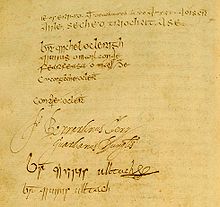- Mícheál Ó Cléirigh
-
Mícheál Ó Cléirigh (c. 1590 – 1643), sometimes known as Michael O'Clery, was an Irish chronicler, scribe and antiquary and chief author of the Annals of the Four Masters, assisted by Cú Choigcríche Ó Cléirigh, Fearfeasa Ó Maol Chonaire, and Peregrinus Ó Duibhgeannain.
Contents
Background and early life
Grandson of Tuathal Ó Cléirigh, a chief of the sept of Uí Chléirigh in Donegal, he was born in Kilbarron near Creevy, between Rossnowlagh and Ballyshannon on Donegal Bay. He was baptized Tadhg Ó Cléirigh and was known by the nickname Tadhg an tSléibhe (meaning Tadhg of the mountain), but took the name of Mícheál when he became a Franciscan friar. He was the youngest of four sons of Donnchadh Ó Cléirigh and his mother was Onóra Ultach. Of his older brothers were Uilliam, Conaire and Maolmhuire, Conaire is known to have worked on the annals as a scribe, while Maolmhuire also became a Franciscan at Louvain.[1] Micheál was a cousin of Lughaidh Ó Cléirigh (fl. 1595-1630), also famous as an Irish historian and author of one of the major sources of the annals.
As a member of one of the foremost learned families of Gaelic Ireland, Ó Cléirigh received a wide-ranging and thorough education. He records that he was taught, for instance, by a Baothghalach Ruadh Mac Aodhagáin, an individual who may have been active in County Tipperary.[1] Tadhg followed Maolmhuire to continental Europe some time after the Flight of the Earls. He may be the Don Tadeo Cleri who was serving as a soldier in Spain in July 1621.[1] At some point before March of 1623 he became a lay brother of the Franciscan order.[1] He was never ordained a priest.
Scholarship
Ó Cléirigh had already gained a reputation as an antiquary and student of Irish history and Irish literature, when he entered the Irish College of St Anthony at Louvain (Dutch:Leuven). In 1624, through the initiative of Aedh Buidh Mac-An-Bhaird (1580-1635), warden of the college, and himself a famous Irish historian and poet, and one of an old family of hereditary bards in Tyrconnell, he began to collect Irish manuscripts and to transcribe everything he could find of historical importance. To do this he returned to Ireland in 1626 and spent over a decade based at a Franciscan house by the River Drowes on the Donegal-Leitrim border.[1] He was assisted by other Irish scholars, most notably Cú Choigcríche Ó Cléirigh, Fearfeasa Ó Maol Chonaire and Peregrinus Ó Duibhgeannain.[1] Ó Cléirigh travelled widely throughout Ireland during this period, collecting and transcribing a vast quantity of Irish texts. His initial focus was material of ecclesiastical importance, particularly saints' lives, but by 1631 he and his colleagues were beginning to copy secular material such as the Irish pseudo-history Leabhar Gabhála.[1]
In 1632 the group began to assemble the most extensive set of Irish annals ever compiled. The project took four years and resulted in the vast collection dubbed Annála Ríoghachta Éireann (Annals of the kingdom of Ireland) but now better known as the Annals of the Four Masters.[2] The 'four masters' in question are Mícheál Ó Cléirigh, Cú Choigcríche Ó Cléirigh, Fearfeasa Ó Maol Chonaire and Peregrine Ó Duibhgeannain and the term was devised by John Colgan.[1] However, other important collaborators included Muiris mac Torna Uí Mhaolchonaire Ó Cléirigh's brother Conaire. The work was completed in August 1636 and two manuscript copies of the annals were made.
Among the other works copied and compiled in this period were Reim Rioghroidhe (Royal List) in 1630, Leabhar Gabhála (Book of Invasions) in 1631, Cogad Gáedel re Gallaib. He subsequently produced his Martyrologium of Irish saints, based on various ancient manuscripts, such as the Martyrology of Tallaght.
Later life and legacy
He returned to the continent in early 1637.[1] The only work by Ó Cléirigh to be published in his lifetime, a glossary called Foclóir nó Sanasán Nua, appeared in 1643.[1] His precise date of death is unknown, but he is generally thought to have died at Louvain in 1643.
Mícheál Ó Cléirigh appears as an historical character in Darach Ó Scolaí's novel, An Cléireach. In 1944, An Post issued two stamps to commemorate the 300th anniversary of the death of Ó Cléirigh.[3] The Mícheál Ó Cléirigh Institute for the Study of Irish History and Civilisation at University College Dublin is named in his honour.[4]
See also
- Cú Choigcríche Ó Cléirigh
- Tadhg Og Ó Cianáin
- Peregrine Ó Duibhgeannain
- Lughaidh Ó Cléirigh
- James Ussher
- Sir James Ware
- Mary Bonaventure Browne
- Dubhaltach Mac Fhirbhisigh
- Ruaidhrí Ó Flaithbheartaigh
- Uilliam Ó Duinnín
- Charles O'Conor (historian)
- Eugene O'Curry
- John O'Donovan (scholar)
References
- ^ a b c d e f g h i j http://www.oxforddnb.com/view/article/20498
- ^ The Annals have been edited and published in digital form as part of the CELT project, University College, Cork: http://celt.ucc.ie/irlpage.html
- ^ http://www.danstopicals.com/4masters.htm
- ^ http://www.ucd.ie/mocleirigh/
- Irish Men of Learning, Paul Walsh, Dublin, 1947
- "Beathaionn na Braithre na Briathra":The Louvain Achievement, Micheal Mac Craigh, in Seanchas Ard Macha v.21-22, 2007-08, pp86-
 This article incorporates text from a publication now in the public domain: Chisholm, Hugh, ed (1911). Encyclopædia Britannica (11th ed.). Cambridge University Press.
This article incorporates text from a publication now in the public domain: Chisholm, Hugh, ed (1911). Encyclopædia Britannica (11th ed.). Cambridge University Press.
External links
Categories:- Irish historians
- 1590s births
- 1643 deaths
- People from County Donegal
- 16th-century Irish people
- 17th-century Irish people
- 17th-century historians
- Irish chroniclers
- Scribes
- Irish expatriates in Belgium
- Irish expatriates in France
Wikimedia Foundation. 2010.

